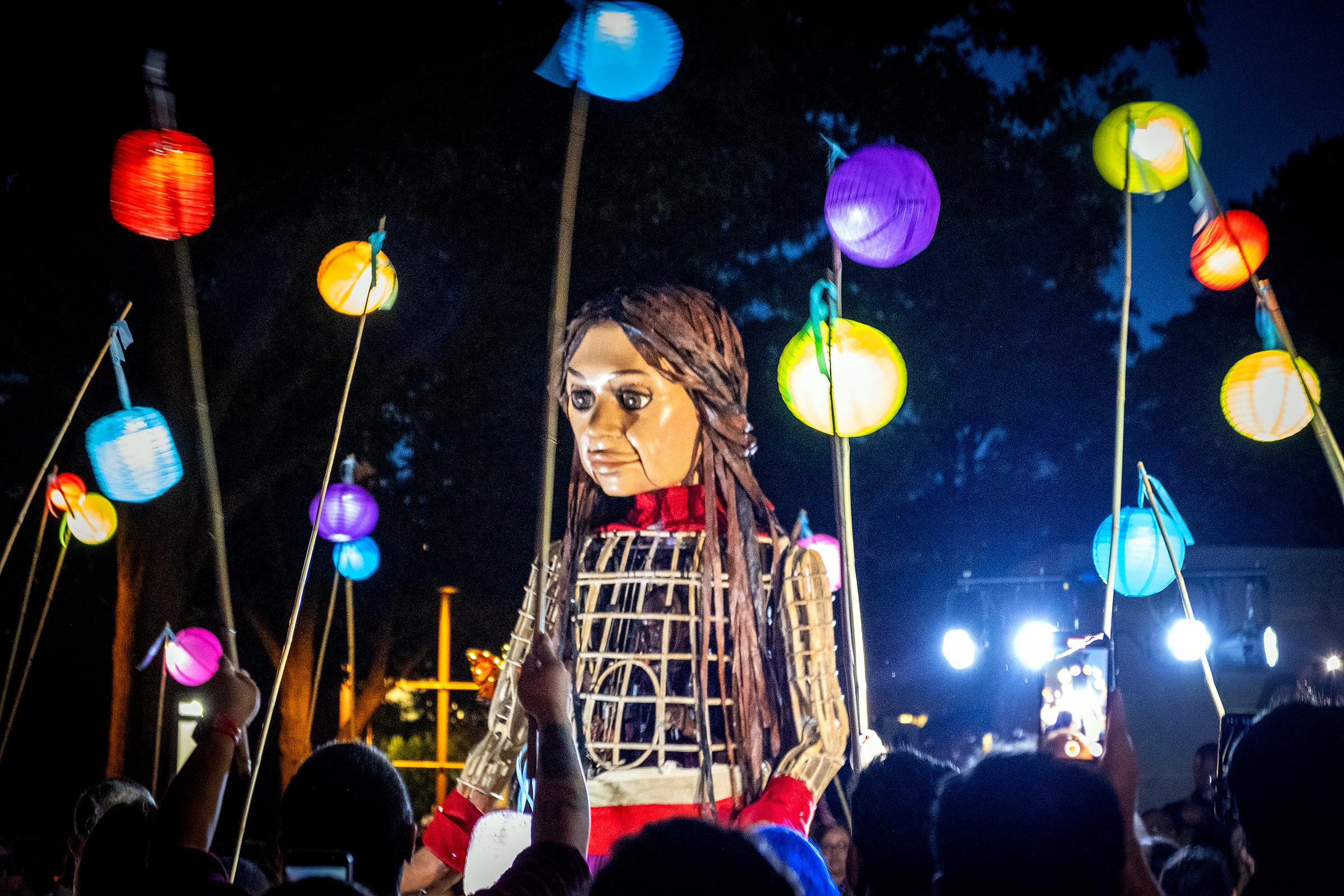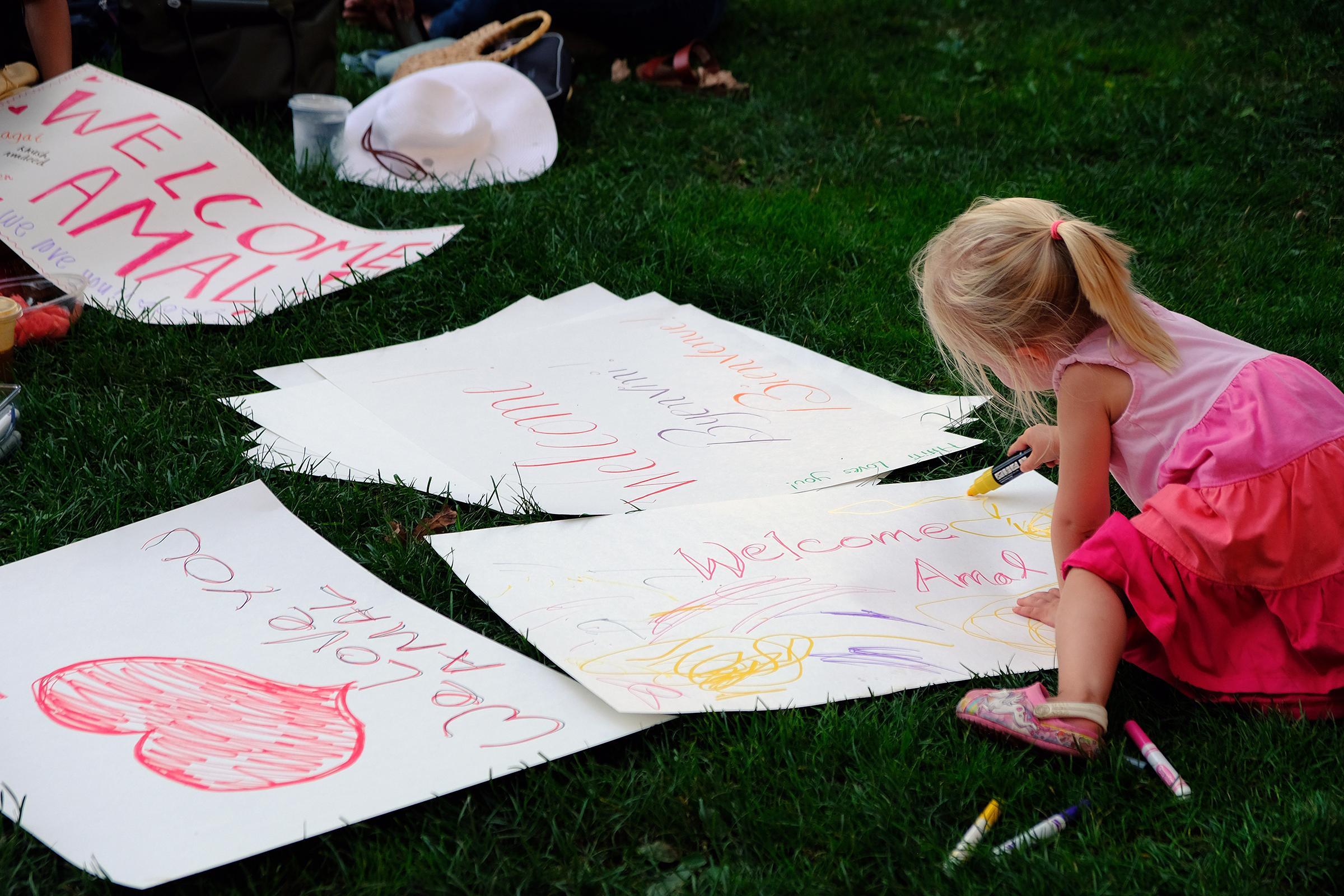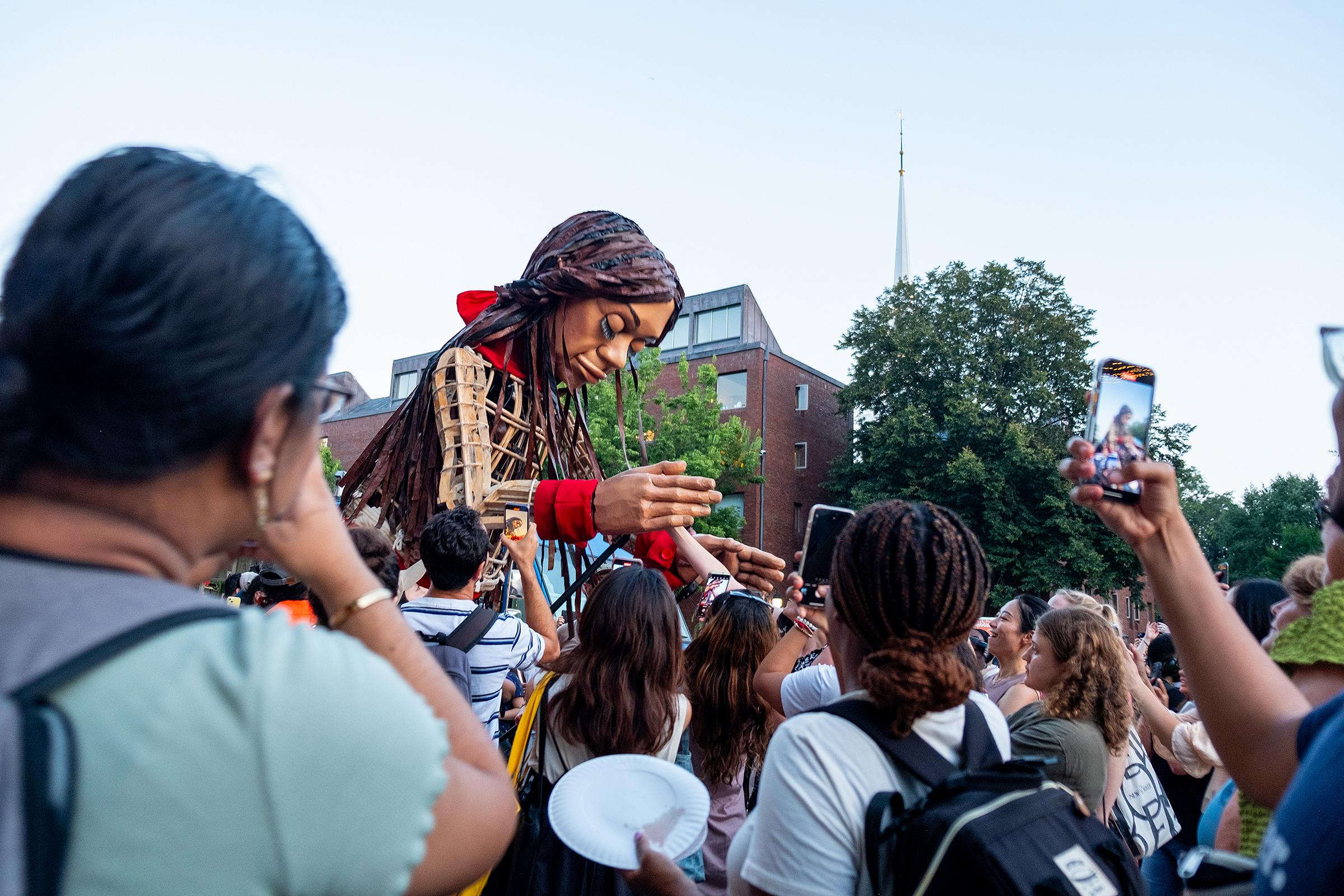12-foot-tall puppet of 10-year-old refugee girl begins 6,000-mile coast-to-coast journey

Why do people throw their energy into art when there are so many real and terrible things happening in the world that also deserve attention? This was one of the many questions which flitted across my mind as I sat on a bench in Harvard’s Science Center Plaza Thursday night.
My thought process was interrupted as a wave of “ooohs” and “aaahs” swept the crowd around me. Onlookers jostled from side to side, craning their necks for a better view as a giant, 12-foot puppet of a girl walked down a footpath into campus, her long hair flowing in the breeze behind her. As though witnessing the arrival of a celebrity, the crowd raised their phones to photograph her and reached out their arms as though to embrace her.
Little Amal, a creation of the Handspring Puppet Company, symbolizes a 10-year-old Syrian refugee searching for her mother. Amal, whose name means “hope” in Arabic, has both literally and metaphorically risen to the scale of the refugee crisis, traveling to 15 different countries since 2021 and becoming a symbol of compassion and human rights. Harvard University was one of her first stops this fall on a 6,000- mile journey from Boston to San Diego, where she will be stopping in over 35 cities and towns along the way, and producing over 100 free arts events in collaboration with over 1,000 artists to draw attention to children fleeing war. (Click here to see the schedule.)

As she arrived on the plaza, the puppeteers who operated her were lost to the crowd below as Amal occupied her own airspace and competed for attention with no one. She embraced a baby on someone’s shoulders, seeming to instinctively know how to pose for photos, bowing and nodding at the crowd as she went.
Yet, as she reached the gates to campus, uncertainty washed over her. Amal appeared momentarily baffled, attempting to go through a smaller gate before realizing that she couldn’t fit and walking through the main entrance.
It was a momentary interaction, but it broke the spell that she had first cast on the crowd.
“What is she doing?” people asked. And I wondered “Is she OK?” already forgetting that she was a puppet.
Amal seemed to quickly lose her poise again and appear overwhelmed as she entered the courtyard, apparently the group’s new unwitting leader. The crowd followed her with some confusion, migrating along the now uncertain path.
Amal leaned against a tree to catch her breath as the crowd caught up to her, and then hid behind another, as though rallying herself to face the crowd again, and then, to the delight of the audience, became a girl once more as she played a brief game of hide and seek behind the John Harvard statue.
In the relative darkness of the courtyard, strange, somewhat ominous music started playing — creeping low strings with flighty, discordant winds on top. The music picked up as people started brushing past Amal on their phones. Amal turned around in confusion, not sure which direction she should pick.
The music eventually slowed. Amal was left standing alone until white bird puppets made of ribbons fluttered out around her and a voice read out a poetic text comparing migrants to birds: “When our wings were shattered we tried to swim, but the waves were too treacherous. Pleas for aid were met with indifference…”

The night’s pinnacle came when we followed Amal around another corner, following the sounds of a gospel choir. The choir grew louder and louder, breaking into a moving and thunderous rendition of Cleophus Robinson Jr.’s “Hold On Just A Little While Longer” at the base of the steps of the Harvard Library.
Amal paused to absorb the music, nodding and swaying, as the birds continued to fly around her.
As they finished, Claudine Gay, the president of Harvard, appeared behind the choir and welcomed Amal with a heartfelt speech.
“Our shield, which is emblazoned with the word ‘veritas,’ meaning ‘truth,’ includes three open books. In those pages are an invitation to linger and to learn, which is what we hope you will do today, Amal, as we warmly welcome you with flowers and we greet you with our wish for peace,” Gay said.
Amal was then presented with flowers, and the evening transformed into a magical, celebratory party. The music became more hopeful — a jazzy saxophone on top of a simple instrumentation lifting spirits as Amal bowed gracefully to all. Lanterns filled the sky, and people danced and swayed along with Amal.
Whereas Amal had been largely alone for most of the night, minus the company of a few ghostly birds, colorful lanterns now danced along at her height. For the first time that night, the crowd felt like a unified, accompanying companion, rather than an imposing external force.
I left feeling like I had barely scratched the surface of what the evening was about. I wish that I knew more about the people who were performing, who had written and read the words spoken in courtyard, and more about all of the partner organizations or how to turn the feelings the event had inspired into action.
But I also couldn’t help but think there was also something beautiful in the mysterious, ephemeral nature of the performance. Instead of our being handed a program and told exactly what to expect, Amal’s passing presence had felt like a strange, surreal, imaginative dream.
Despite the hopeful tone of the evening, I also couldn’t help but hear the comments I had read online before the event echoing in my mind, claiming that Amal looked creepy.
As I watched the performance in Harvard Yard, however, this felt like a feature, rather than a bug, of her design. Amal does have something of a drawn face. The large lines which fall down from her chin make her seem sad, or older than the 10 year old child she’s supposed to portray. The idea of a sad little girl looming large over a crowd, moving apparently of her own accord in search of her mother, does seem a little unsettling.
But I don’t think her presence alone is supposed to be comforting. Just as the music of the night occasionally bordered on ominous, Amal herself represents an unsettling narrative. She’s a little too large, a little too “other” for comfort, especially as she embodies a narrative many attempt to underplay. This was part of her magic: By the end of the night she had broken into a familiar and small child, one who has a unique personality and joys and fears. Her sadness and inability to blend into the crowd reads as part of the disjunction and the provocation of the art, challenging us to engage with difficult emotions and confront preconceptions and baseless fears.
Adding another dark, self-reflexive, layer on top of the spectacle, Amal is constantly surrounded by smartphone-wielding onlookers, paralleling the media circus that sometimes surrounds and dehumanizes those at the center of the refugee crisis to little benefit.
Even as the glow of phone screens danced along with the lanterns at the end of the performance, I wondered: What happens after this?
Of course, the crowd dispersed at the end, but the courtyard didn’t look the same as it did before Amal had passed through. People lingered, talking to one another, listening to the closing notes of music, or thinking of Amal and her journey.
In the end, I found Little Amal’s journey to be more than just an aesthetic spectacle. She changed the narrative of the night, leading us from spectacle to disorientation; from confusion to hope, awe, and potential. While some might argue that directing all of this care and attention at a puppet while real refugees go unnoticed and unattended feels injudicious, the program’s charitable fund along with mindful curation of concurrent local events helps to ensure that Amal’s presence holds meaningful and lasting impact and offsets these critiques. Amal serves as a conduit for empathy and understanding of issues both global and local, her presence a testament to hope in darkness, art’s ability to inspire new narratives, and humanity’s capacity to transcend barriers.
Amal visits Hartford on Sept. 11, then Philadelphia for a series of events Sept. 13 – 14. Here’s the full itinerary.
Where I’m going next: Antique Table Restaurant.






